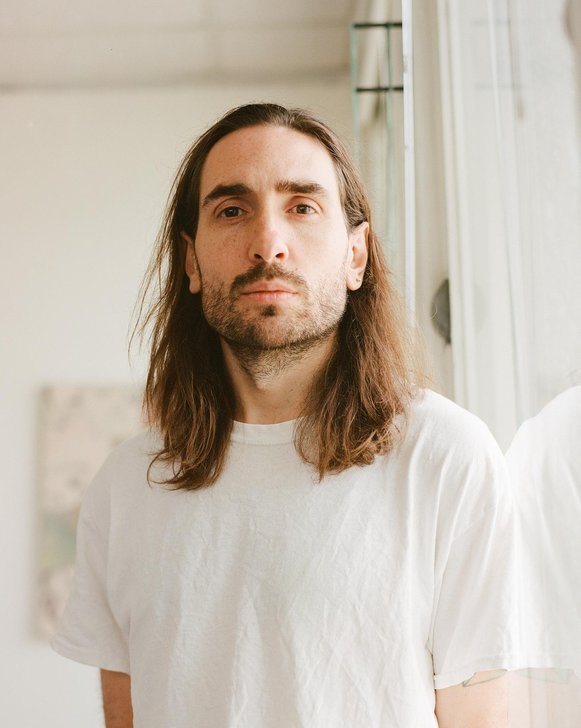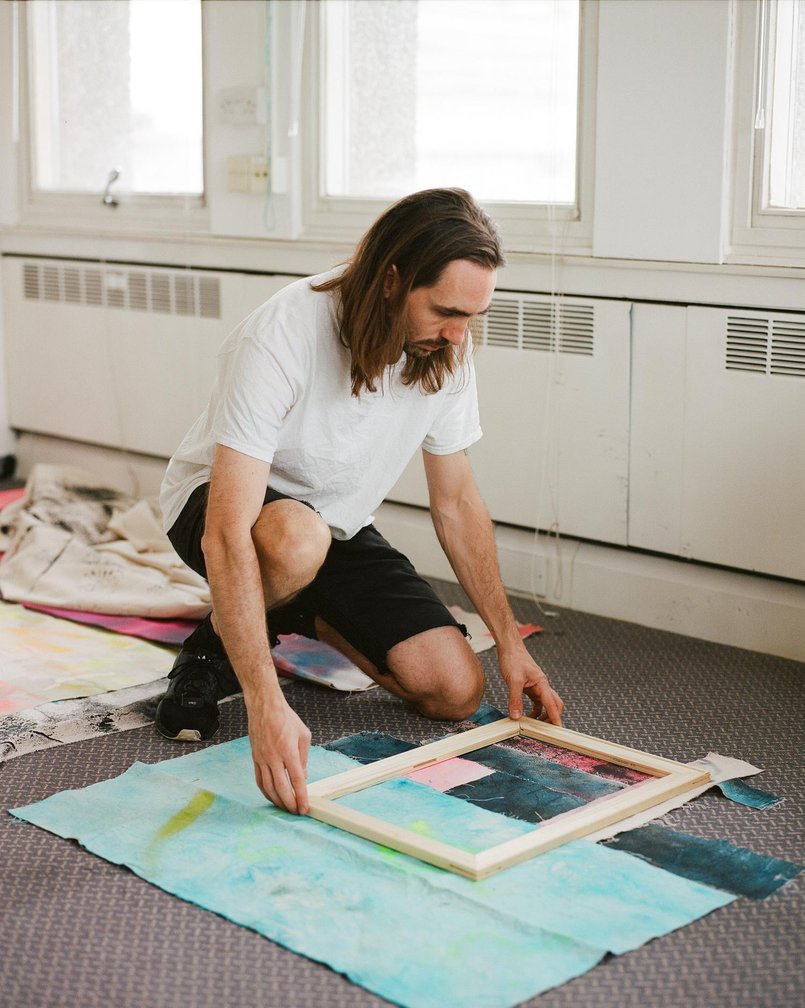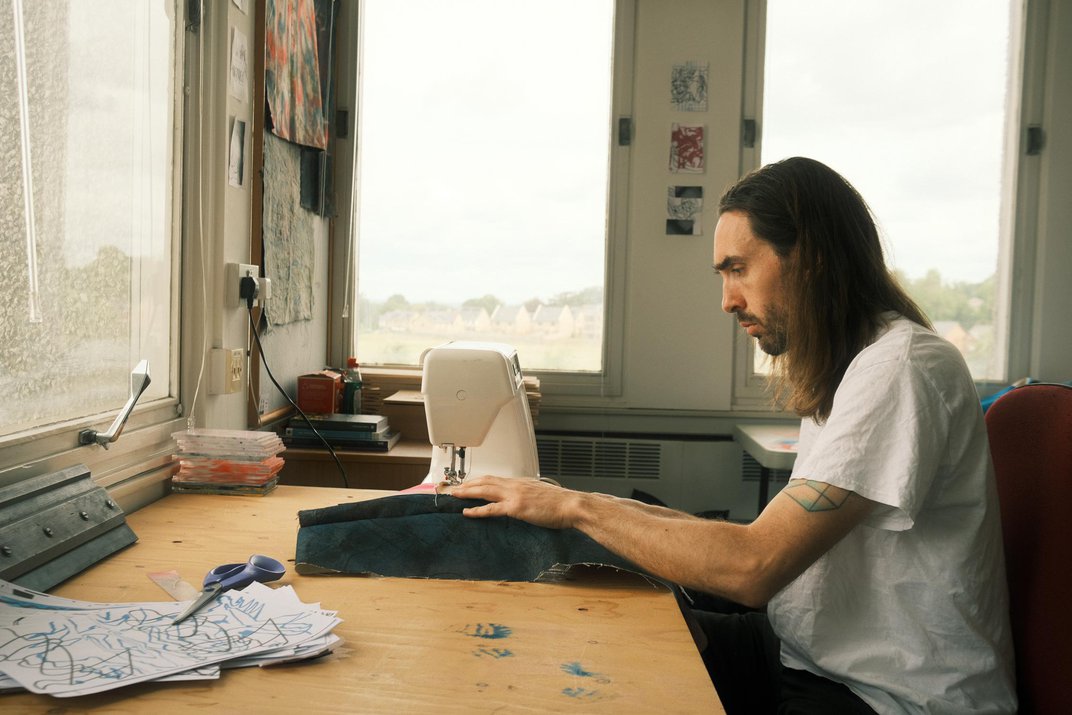article In conversation with
Ralph-Hunter Menzies
In conversation with
Ralph-Hunter Menzies
Ralph-Hunter Menzies

In conversation with Ralph Hunter-Menzies
about the accidental vs the deliberate
and prioritising exploration and
experimentation.
about the accidental vs the deliberate
and prioritising exploration and
experimentation.
In conversation with Ralph Hunter-Menzies
about the accidental vs the deliberate
and prioritising exploration and
experimentation.

Influenced by DIY culture, artist Ralph Hunter-Menzies cuts, composes, and reassembles the pieces of fabric using a sewing machine. This, combined with blasted paint, printing, and dye experimentation, results in a balancing act between deliberate and accidental marks, equally delicate as they are disruptive.

Artiq You are interested in the relationship between deliberate and accidental mark-making within your practice. Can you speak a bit more about these processes? How do they inform one another?
Ralph I often work in layers, with the surfaces being placed on top of each other while I work. This means there’s accidental marks or residue that tends to mark other surfaces. These marks then tend to inform my deliberate marks. I also use multiple processes that are hard to fully control. These include power washing, soaking, using masking fluid and sanding. I usually work on surfaces over a long period of time, so the material holds a story and a history that informs the composition. The aim for all my works is to discover an unknown, be it a relationship with a surface, a new process, working method or compositional surprises.
Artiq You studied BA in Fine Art at Chelsea College of Arts, London. How did you find the journey to becoming an artist after graduating? What advice would you give to recent arts graduates?
Ralph I think I did it the long way around; I’d say focus on what you want to say early on. I focused on showing, which had many positive outcomes, but I didn’t allow myself the time to understand my practice. I now have a working method and approach that prioritises exploration and experimentation and therefore I enjoy making work now.
Artiq What pieces or series are you currently working on? How do you decide what to work on next?
Ralph I’m going through a process of exploring different methods of constructing these works. I’ve been thinking about and experimenting with the possibility of making larger works from a series of smaller works. I enjoy the idea that the work would almost become modular and therefore have many possible combinations to create the final composition.
Ralph I often work in layers, with the surfaces being placed on top of each other while I work. This means there’s accidental marks or residue that tends to mark other surfaces. These marks then tend to inform my deliberate marks. I also use multiple processes that are hard to fully control. These include power washing, soaking, using masking fluid and sanding. I usually work on surfaces over a long period of time, so the material holds a story and a history that informs the composition. The aim for all my works is to discover an unknown, be it a relationship with a surface, a new process, working method or compositional surprises.
Artiq You studied BA in Fine Art at Chelsea College of Arts, London. How did you find the journey to becoming an artist after graduating? What advice would you give to recent arts graduates?
Ralph I think I did it the long way around; I’d say focus on what you want to say early on. I focused on showing, which had many positive outcomes, but I didn’t allow myself the time to understand my practice. I now have a working method and approach that prioritises exploration and experimentation and therefore I enjoy making work now.
Artiq What pieces or series are you currently working on? How do you decide what to work on next?
Ralph I’m going through a process of exploring different methods of constructing these works. I’ve been thinking about and experimenting with the possibility of making larger works from a series of smaller works. I enjoy the idea that the work would almost become modular and therefore have many possible combinations to create the final composition.

Artiq You often cut up and re-assemble materials within your practice, frequently placing contrasting colours and patterns together. How do you decide on these arrangements? Do you plan what the final piece will look like beforehand?
Ralph I tend to have a rough idea of what I’m looking for, but that idea is usually only alive in the final work as an essence or a distant memory. I spend the majority of my time cutting, placing, sewing and resewing areas until there’s something that encompasses both accidental and deliberate marks, or something that keeps me interested in the surface. The interesting thing about the way I work is that there isn’t any way to completely control the final composition; I stretch the work after the surface is fully assembled and can’t see the final crop. This is something I’ve encouraged and embraced within the works.
Artiq Which artist has had the most significant influence on your practice? What have you learnt from them?
Ralph Gordon Matta-Clark’s approach to architecture is the single biggest ongoing influence to me. All my works come from observations and interests in how people use and shape architecture and how that comes to shape them. Gordon Matta-Clark’s interest in questioning traditional notions of architecture, by cutting and dismantling buildings, helped me first start exploring liminal spaces within cityscapes. One of the most important lessons from Gordon Matta-Clark would have to be the power of very simple and minor interventions.
Another artist that influences me a lot is John Divola, especially his Zuma series, where he went to abandoned buildings and did interventions within the space and photographed them as the sunsets. This series is a visual masterclass in editing and composition.
Ralph I tend to have a rough idea of what I’m looking for, but that idea is usually only alive in the final work as an essence or a distant memory. I spend the majority of my time cutting, placing, sewing and resewing areas until there’s something that encompasses both accidental and deliberate marks, or something that keeps me interested in the surface. The interesting thing about the way I work is that there isn’t any way to completely control the final composition; I stretch the work after the surface is fully assembled and can’t see the final crop. This is something I’ve encouraged and embraced within the works.
Artiq Which artist has had the most significant influence on your practice? What have you learnt from them?
Ralph Gordon Matta-Clark’s approach to architecture is the single biggest ongoing influence to me. All my works come from observations and interests in how people use and shape architecture and how that comes to shape them. Gordon Matta-Clark’s interest in questioning traditional notions of architecture, by cutting and dismantling buildings, helped me first start exploring liminal spaces within cityscapes. One of the most important lessons from Gordon Matta-Clark would have to be the power of very simple and minor interventions.
Another artist that influences me a lot is John Divola, especially his Zuma series, where he went to abandoned buildings and did interventions within the space and photographed them as the sunsets. This series is a visual masterclass in editing and composition.

Artiq You frequently use a sewing machine within your work to stitch pieces of canvas together. How did you begin combining sewing and painting together? What drew you to this way of working?
Ralph It was originally borne out of a frustration and inability to find what I was searching for in a traditional approach to painting. The process of sewing involves so many unknowns and it allows you the ability to edit and crop in ways unthinkable within traditional painting parameters.
Artiq Do you have any upcoming projects or exciting events that you would like to share with us?
Ralph Currently just working away on new series and looking forward to showing in the future!
Ralph It was originally borne out of a frustration and inability to find what I was searching for in a traditional approach to painting. The process of sewing involves so many unknowns and it allows you the ability to edit and crop in ways unthinkable within traditional painting parameters.
Artiq Do you have any upcoming projects or exciting events that you would like to share with us?
Ralph Currently just working away on new series and looking forward to showing in the future!